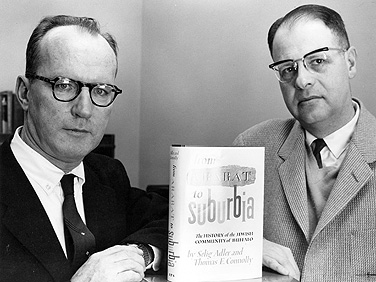Flashback
50 years ago
From Ararat to suburbia

Professors Thomas Connolly and Selig Adler chronicled the history of the Jewish community in Buffalo and Western New York. Photo: UB ARCHIVES
When UB professors Selig Adler and Thomas E. Connolly wrote their history of the Jewish community of Buffalo and Western New York, they began the chronicle with Mordecai Manuel Noah’s attempt to establish a refuge for Jews on Grand Island.
It was in 1825, the same year that the Erie Canal opened, that Mordecai Noah, a man of many talents, tried to establish a Jewish haven to be named Ararat after the believed resting place of the Biblical Noah’s Ark. Envisioned for the head of the island where the Erie Canal met the Niagara River, Noah planned for Ararat to rival Buffalo.
There was virtually no support for Noah’s plan. As the terminus of the Erie Canal and with the aid of an expanding Jewish population of business and professional leaders, Buffalo would flourish without a rival city located on Grand Island. It was the period between Noah’s failed attempt to establish a Jewish haven in 1825 and the migration by many in Buffalo’s Jewish community to the suburbs in the late 1950s that would be the framework of Adler and Connolly’s research.
The project to produce a history of the local Jewish community was initiated by the United Jewish Federation of Buffalo in 1954. Writing in the preface, Adler and Connolly described how researchers and volunteers identified and examined manuscripts, newspaper files, obituaries, census reports, city directories and minutes of organization meetings.
With an extensive bibliography, “mounds of notes” and information from interviews, the authors began the task of writing. “We hoped that the collaboration of a Jewish historian and a non-Jewish student of literature might at once provide the essential knowledge of things Jewish, sound historical craftsmanship and an objectively fundamental to the treatment of a complex community.”
After Adler retired from UB in 1980, he became archivist of the Jewish Federation of Greater Buffalo. The Jewish Archives of Greater Buffalo, containing some of the material used in the writing of “From Ararat to suburbia,” eventually was located in the library of Buffalo State College (Adler died in 1984, Connolly in 2002). In 2007, this extensive archive was transferred to UB by the Jewish Federation of Greater Buffalo, and the following year an exciting collaboration between the UB Archives and the Bureau of Jewish Education of Greater Buffalo began.
The Jewish Buffalo Archives Project was established to identify and preserve those “historical materials that document the lives of Jews in the greater Buffalo and Niagara regions.” Material collected as part of the project is being transferred to UB, where it will be preserved and made accessible. By collecting and preserving these historical records, the Jewish Buffalo Archives Project also is continuing and supplementing the identification and collecting of records done by Adler and Connolly more than 50 years ago.
Last month the New York State Archives recognized the current collaboration between UB and the Jewish Buffalo Archives Project with the 2010 Debra E. Bernhardt Annual Archives Award for Excellence in Documenting New York’s History. Click here to read a story on the award.
There has long been a relationship between UB and local Jewish community. In the 19th century, many Jewish men received their professional training at UB, and with the establishment of the College of Arts and Sciences in 1913, UB “became a godsend to poverty-stricken immigrant children of all nationalities,” wrote Adler and Connolly. As the two also noted, at a time when many colleges managed to limit the number of Jewish students admitted, Chancellor Samuel P. Capen established that at UB “there would be no discrimination against minorities on either the student or faculty level.”
—John Edens, University Archives

Reader Comments